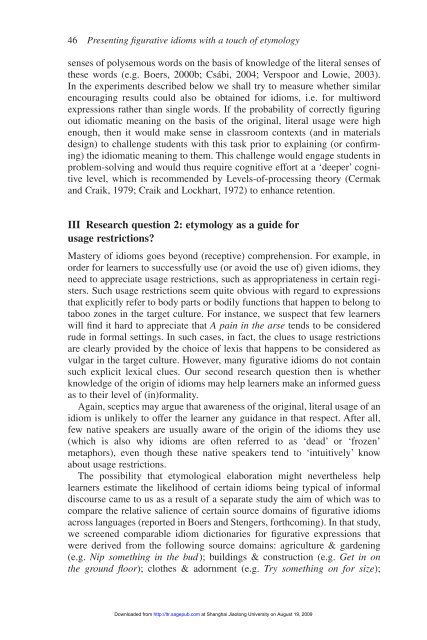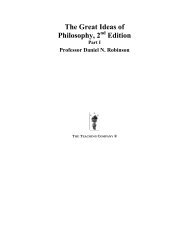Language Teaching Research
Language Teaching Research
Language Teaching Research
You also want an ePaper? Increase the reach of your titles
YUMPU automatically turns print PDFs into web optimized ePapers that Google loves.
46 Presenting figurative idioms with a touch of etymology<br />
senses of polysemous words on the basis of knowledge of the literal senses of<br />
these words (e.g. Boers, 2000b; Csábi, 2004; Verspoor and Lowie, 2003).<br />
In the experiments described below we shall try to measure whether similar<br />
encouraging results could also be obtained for idioms, i.e. for multiword<br />
expressions rather than single words. If the probability of correctly figuring<br />
out idiomatic meaning on the basis of the original, literal usage were high<br />
enough, then it would make sense in classroom contexts (and in materials<br />
design) to challenge students with this task prior to explaining (or confirming)<br />
the idiomatic meaning to them. This challenge would engage students in<br />
problem-solving and would thus require cognitive effort at a ‘deeper’ cognitive<br />
level, which is recommended by Levels-of-processing theory (Cermak<br />
and Craik, 1979; Craik and Lockhart, 1972) to enhance retention.<br />
III <strong>Research</strong> question 2: etymology as a guide for<br />
usage restrictions?<br />
Mastery of idioms goes beyond (receptive) comprehension. For example, in<br />
order for learners to successfully use (or avoid the use of) given idioms, they<br />
need to appreciate usage restrictions, such as appropriateness in certain registers.<br />
Such usage restrictions seem quite obvious with regard to expressions<br />
that explicitly refer to body parts or bodily functions that happen to belong to<br />
taboo zones in the target culture. For instance, we suspect that few learners<br />
will find it hard to appreciate that A pain in the arse tends to be considered<br />
rude in formal settings. In such cases, in fact, the clues to usage restrictions<br />
are clearly provided by the choice of lexis that happens to be considered as<br />
vulgar in the target culture. However, many figurative idioms do not contain<br />
such explicit lexical clues. Our second research question then is whether<br />
knowledge of the origin of idioms may help learners make an informed guess<br />
as to their level of (in)formality.<br />
Again, sceptics may argue that awareness of the original, literal usage of an<br />
idiom is unlikely to offer the learner any guidance in that respect. After all,<br />
few native speakers are usually aware of the origin of the idioms they use<br />
(which is also why idioms are often referred to as ‘dead’ or ‘frozen’<br />
metaphors), even though these native speakers tend to ‘intuitively’ know<br />
about usage restrictions.<br />
The possibility that etymological elaboration might nevertheless help<br />
learners estimate the likelihood of certain idioms being typical of informal<br />
discourse came to us as a result of a separate study the aim of which was to<br />
compare the relative salience of certain source domains of figurative idioms<br />
across languages (reported in Boers and Stengers, forthcoming). In that study,<br />
we screened comparable idiom dictionaries for figurative expressions that<br />
were derived from the following source domains: agriculture & gardening<br />
(e.g. Nip something in the bud); buildings & construction (e.g. Get in on<br />
the ground floor); clothes & adornment (e.g. Try something on for size);<br />
Downloaded from<br />
http://ltr.sagepub.com at Shanghai Jiaotong University on August 19, 2009














